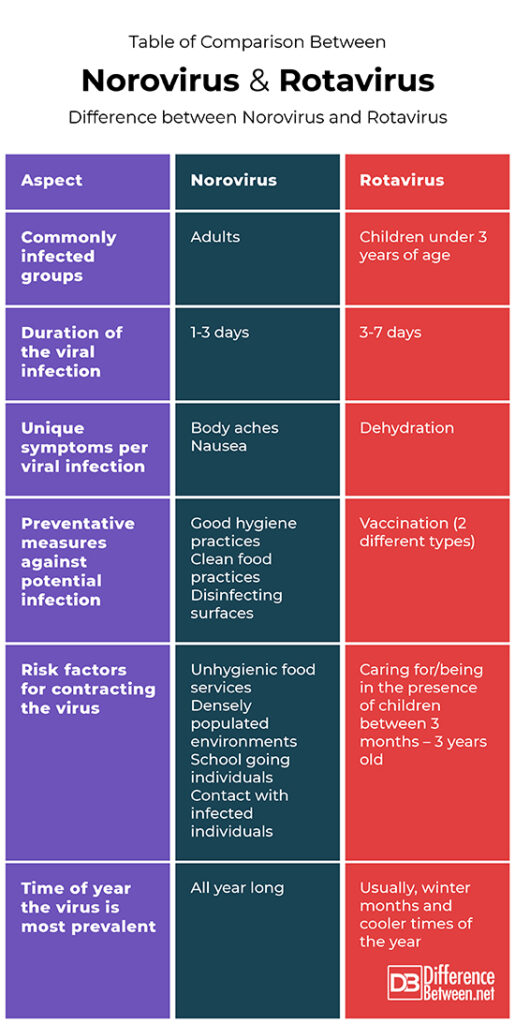Difference Between Norovirus and Rotavirus

Introduction
Norovirus and Rotavirus are both highly contagious viral infections resulting in potential dehydration from effects such as diarrhoea. The norovirus belongs to the viral family Caliciviridae and is a round shaped virus, whereas the rotavirus belongs to the viral family Reoviridae and is a wheel-like shaped virus. The nature of these two types of viruses differs in terms of how they are picked up, when they usually occur, and across which population dynamics they seem to be more prevalent. Despite these differences, norovirus and rotavirus should be effectively treated to prevent severe health complications.
Follow us through this article as we learn more about what makes these viruses so different!

Definition and Pathophysiology
Norovirus is a viral infection belonging to the Caliciviridae family that usually shows up in the body between 12-48 hours after infection. The norovirus is highly contagious and can be passed on when in close contact with an infected person. It is a virus which results in rapid and intense vomiting and diarrhoea, lasting up to three days.
Rotavirus is a viral infection belonging to the Reoviridae family that can be contracted into the body and shows up within 48 hours after infection. The rotavirus is also highly contagious and can be passed on between individuals. The rotavirus, unlike the norovirus, is usually seen to occur mostly in children.
Potential causes
Norovirus is shed in the faecal waste of infected humans and infected animals. This infection can be caused when ingesting contaminated food or water, coming into contact with an infected person, or touching a contaminated surface and then your mouth.
Rotavirus occurs in the faecal waste of infected humans. Infection can occur through hand to mouth contact after contamination (even when the infected person has no symptoms at all!). Contaminated food, surfaces and objects are also spreaders of the virus for weeks. Because this virus mainly occurs in children under 5 years of age, contamination after contact with diapers is a high possibility.
Symptoms
The symptoms associated with norovirus typically present as:
- Nausea and vomiting
- Abdominal area pain
- Fever and body aches
- Extensively watery diarrhoea
The symptoms associated with rotavirus usually include:
- Vomiting
- Stomach pain
- Fever
- Extensively watery diarrhoea
- Moderate to severe forms of dehydration
Risk Factors
Risk factors for norovirus infection include eating at places where food isn’t hygienically handled, going to school, residing in densely populated environments, coming into contact with infected individuals.
Norovirus usually occurs anytime throughout the year.
Factors that place you at risk for rotavirus infection mostly include caring for or being in the presence of children between the ages of 3 months to 3 years old.
Rotavirus usually occurs during the colder months of the year.
Treatment and Prevention
There is no specific treatment for norovirus, but replacement of lost electrolytes and hydration is important. Anti-diarrheal medications are recommended in severe cases and can be prescribed by a doctor.
Infection of norovirus can be potentially prevented through regular hand washing, hygienic food practices, disinfecting contaminated surfaces and items, and cleaning areas where vomiting and diarrhoea occurred.
Rotavirus does not have a specific treatment method, but oral rehydration to replenish electrolytes is encouraged. Anti-diarrheal medication is not recommended for this infection.
Rotavirus can be prevented through the vaccination of infants with one of the two developed rotavirus vaccines.
Table of comparison between Norovirus and Rotavirus

Summary
The norovirus and rotavirus both affect the body and cause severe vomiting and diarrhoea. Norovirus occurs all year round and usually affects the adult population. Rotavirus seems to occur more frequently in the cooler months of the year and mostly infect children between the age of 3 months and 3 years old.
The norovirus is relatively short lived, resulting in illness over 1-3 days. The rotavirus has a longer period of illness, with patients being sick for up to a week. Both viruses have no set treatment, but anti-diarrheal medication is not recommended for rotavirus patients. Norovirus can cause infection through unhygienic food handling practices, living in densely populated environments, school going individuals and coming into contact with those infected. Rotavirus mostly causes infection through handling infected children and their products (such as changing diapers and not washing your hands).
Preventative action for the norovirus is mainly focused on good hygiene practices and cleaning surfaces, where the rotavirus has a vaccine which is effective for prevention.
FAQ
Are norovirus and rotavirus the same?
No. Norovirus belongs to the family Caliciviridae and mostly occurs in adults. Rotavirus belongs to the viral family Reoviridae and most occurs in children. Both viruses cause similar symptoms and have similar treatments. However, preventative measures are different, and they belong to different genetic viral families.
What is the difference between norovirus and gastroenteritis?
The norovirus is the virus that causes gastroenteritis. Gastroenteritis can be caused by many other viruses too, but the leading causative culprit is the norovirus.
What are the first signs of norovirus?
The initial signs of norovirus appear within 12 to 48 hours. These include diarrhoea, vomiting and severe abdominal paint.
Are norovirus and stomach flu the same?
Stomach flu is another name for gastroenteritis, among other names like “viral gastro”. Even though gastroenteritis is caused by a range of viruses, one of the main causes is the norovirus. Therefore, norovirus can be considered the same as stomach flu, viral gastro or gastroenteritis.
- Difference Between a Cochlear Implant and Normal Hearing - October 4, 2022
- Difference Between Obstructive and Restrictive Spirometry - September 11, 2022
- The Difference Between White Box and Black Box Testing - September 11, 2022
Search DifferenceBetween.net :
Leave a Response
References :
[0]Australian Government Department of Health. “Appendix 2: Public fact sheet on norovirus gastroenteritis”. Guidelines for the public health management of gastroenteritis outbreaks due to norovirus or suspected viral agents in Australia. 2010. https://www1.health.gov.au/internet/publications/publishing.nsf/Content/cda-cdna-norovirus.htm-l~cda-cdna-norovirus.htm-l-app2#:~:text=There%20are%20many%20viruses%20that,'%20and%20'viral%20gastro'.
[1]O’ Schroeder, Michael. “Norovirus, Rotavirus or Stomach Flu: What’s the Difference?”. US News: Health, 2019. https://health.usnews.com/conditions/norovirus/articles/rotavirus-vs-norovirus
[2]Sai, Lintao., Sun, Jitang., Chen, Shuai., Liu, Haihong and Ma, Lixian. “Epidemiology and clinical features of rotavirus and norovirus infection among children in Ji’nan, China”. Virology Journal, vol. 10, no. 302, 2013, pp. 1-8.
